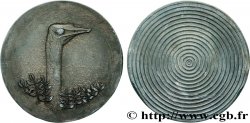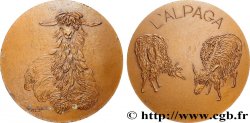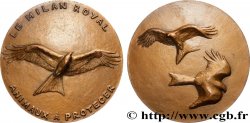fme_1043011 - ANIMALS Médaille animalière - Milan Royal
70.00 €
Quantità
Aggiungi al carrello

Tipo : Médaille animalière - Milan Royal
Data: 1982
Nome della officina / città: Monnaie de Paris
Metallo : bronzo
Diametro : 67,5 mm
Asse di coniazione : 12 h.
Incisore HARMSWORTH Margareth (1926-)
Peso : 218,09 g.
Orlo : lisse + 1982 + corne BRONZE
Marchio : corne BRONZE
Commenti sullo stato di conservazione:
Patine hétérogène. Présence de coups et rayures, notamment sur la tranche
N° nelle opere di riferimento :
Diritto
Titolatura diritto : LE MILAN ROYAL - ANIMAUX A PROTÉGER.
Descrittivo diritto : Milan royal en plein vol. Signé : HARMSWORTH.
Rovescio
Titolatura rovescio : ANÉPIGRAPHE.
Descrittivo rovescio : Deux milans royaux en vol.
Commento
Née à Paris en 1926, de mère américaine et de père anglais, Margareth Harmsworth a été éduquée aux États Unis où elle a commencé à peindre à l’école Brearley à New-York, et aux universités de Vassar et de Sarah Lawrence. Retournée en Europe en juin 1950, elle y commença la sculpture à Florence. Elle fut commissionnée par la Monnaie de Paris pour créer des médailles à partir de 1972.
Le Milan royal (Milvus milvus) est une espèce de rapaces peuplant le Paléarctique occidental.
En ancien français et encore au XVIe siècle, il est appelé escoufle. Son plumage est brun roux dessus, strié de noir dessous, sa tête, sa nuque, sa gorge sont blanchâtres striées de sombre. Ses yeux ont un contour vert avec un point noir au milieu. La femelle est un peu plus terne. Le bec est jaune à la base, gris à l'extrémité et arrondi comme un mini crochet. En vol, il présente une silhouette caractéristique, avec ses longues ailes étroites et fortement coudées, des taches claires sous les ailes et sa queue échancrée..
Born in Paris in 1926 to an American mother and an English father, Margareth Harmsworth was educated in the United States, where she began painting at the Brearley School in New York and at Vassar and Sarah Lawrence Universities. Returning to Europe in June 1950, she began sculpting in Florence. She was commissioned by the Paris Mint to create medals starting in 1972. The Red Kite (Milvus milvus) is a species of raptor found in the Western Palearctic. In Old French, and still in the 16th century, it was called an escoufle. Its plumage is reddish-brown above, streaked with black below; its head, nape, and throat are whitish streaked with dark. Its eyes have a green border with a black dot in the middle. The female is a little duller. The beak is yellow at the base, gray at the tip, and rounded like a mini-hook. In flight, it has a characteristic silhouette, with its long, narrow, strongly angled wings, light spots under the wings and its notched tail.
Le Milan royal (Milvus milvus) est une espèce de rapaces peuplant le Paléarctique occidental.
En ancien français et encore au XVIe siècle, il est appelé escoufle. Son plumage est brun roux dessus, strié de noir dessous, sa tête, sa nuque, sa gorge sont blanchâtres striées de sombre. Ses yeux ont un contour vert avec un point noir au milieu. La femelle est un peu plus terne. Le bec est jaune à la base, gris à l'extrémité et arrondi comme un mini crochet. En vol, il présente une silhouette caractéristique, avec ses longues ailes étroites et fortement coudées, des taches claires sous les ailes et sa queue échancrée..
Born in Paris in 1926 to an American mother and an English father, Margareth Harmsworth was educated in the United States, where she began painting at the Brearley School in New York and at Vassar and Sarah Lawrence Universities. Returning to Europe in June 1950, she began sculpting in Florence. She was commissioned by the Paris Mint to create medals starting in 1972. The Red Kite (Milvus milvus) is a species of raptor found in the Western Palearctic. In Old French, and still in the 16th century, it was called an escoufle. Its plumage is reddish-brown above, streaked with black below; its head, nape, and throat are whitish streaked with dark. Its eyes have a green border with a black dot in the middle. The female is a little duller. The beak is yellow at the base, gray at the tip, and rounded like a mini-hook. In flight, it has a characteristic silhouette, with its long, narrow, strongly angled wings, light spots under the wings and its notched tail.








 Segnalare un errore
Segnalare un errore Stampate la pagina
Stampate la pagina Condividi mia selezione
Condividi mia selezione Fai una domanda
Fai una domanda Consegnare / vendere
Consegnare / vendere
 Descrittivo
Descrittivo










